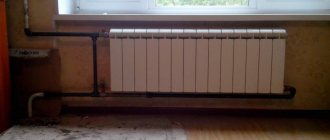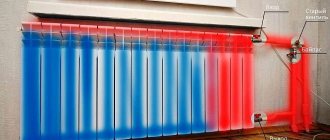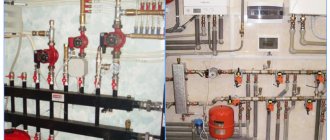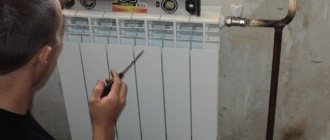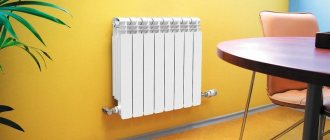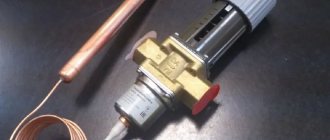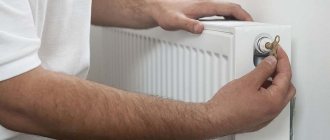How to adjust the temperature in the apartment
- If the apartment is often hot to such an extent that there is a desire to turn off the radiators, consider installing temperature regulators on the radiators. If the battery has a bypass, you can install a thermostat at the entrance to the battery, which will regulate the temperature in the room.
- If there is no bypass, it is prohibited to install control devices, since if such devices are present, you will set the temperature not only in your apartment, but also for all your neighbors in the riser. In this case, you can replace the heating battery and install a bypass.
To shut off the heating device, ball valves are required.
For those who live in houses with central heating, questions about how to turn off the radiator usually arise in two cases:
- if the weather is warm outside and the central heating has not yet been turned off, since the heating season has not officially ended;
- if necessary, replace, repair or paint the radiator, repair the wall behind the radiator.
In this case, one should take into account this point: there is always a coolant inside the battery. It is drained only in case of repair work in the system
This is due to the fact that the main part of the heating devices installed in old houses, as well as the intra-house wiring, are made of steel.
The liquid inside the heating battery contains a certain amount of oxygen in dissolved form, which over time completely reacts with the metal, as a result of which corrosion stops.
You cannot leave the system or a separate heating device unfilled for a long time - moisture remains on the inner surface of the steel or cast iron battery, which does not evaporate for a long time in a confined space. This significantly accelerates the corrosion process. Thus, the coolant is drained only in exceptional cases.
Recommendations for installing devices
To be able to regulate the temperature of the battery in the apartment, consider any type of valve: they can be straight or angular. The installation principle of such a device is simple; the main thing is to correctly determine its position. Thus, the direction of coolant flow is indicated on the valve body. It must correspond to the direction of water movement inside the battery.
Place valves/thermostats at the inlet of the heating device; if necessary, install a tap at the outlet as well. This is done so that in the future it will be possible to independently drain the coolant. Regulating devices are installed on heating radiators, provided that the user knows exactly which pipe is the supply pipe, since a tap is made into it. In this case, the direction of movement of hot water in the riser is taken into account: from top to bottom or from bottom to top.
Compression fittings are more reliable, which is why they are used more often. The connection to the pipes is threaded. Thermostats can be equipped with a union nut. To seal the threaded connection, use FUM tape or flax.
If you need to shut off and remove the radiator
It is best to carry out work related to radiator removal after the end of the heating season. If work needs to be carried out during the heating season, you need to take into account a number of nuances. If you have a single-pipe heating system and vertical wiring, you can remove the battery only if there is a bypass.
Such a system can be identified by pipes, one of which comes from the ceiling and connects to the radiator, and the other comes out of the radiator and disappears into the floor. A bypass is a jumper connecting the incoming and outgoing pipes. This is a pipe of approximately the same or slightly smaller diameter than the main pipes. The principle of the bypass is as follows: if the radiator is turned off, water begins to flow through the riser, passing through the bypass, without passing through the battery. In this case, the riser works, the heating in neighboring apartments does not turn off.
If the system is two-pipe, if there are taps, it is enough to close them, after which you can remove the battery.
Installation
Since a ball valve is the most popular type of shutoff of liquid entering the battery, we will consider detailed instructions for installing such a device.
Before starting work, it is necessary to completely remove the coolant from the heating system, that is, completely shut off the water supply. The ball valve must be installed in the area between the radiator and the bypass - a device that ensures proper water circulation in the system.
Before installation, you need to wrap the tap threads with a special sealant for better sealing. There are a few things to consider when installing a faucet. Firstly, nothing should interfere with turning the faucet handle, no obstacles in the form of pipes or other elements, but if something interferes, then it is necessary to reduce the handle. Also, the user of the heating system must have a convenient approach to the faucet handle.
After this, you can safely install the tap, but you also need to take into account the thread. After installation, it is necessary to check the connections for leaks and various leaks, in order to avoid them you should not spare the sealant - a special sealing tape that can be purchased at any hardware store.
After this, you can install the battery. It is necessary to check all connections for leaks by turning on the water supply, preferably at high pressure.
Thus, installing a tap on heating radiators requires only a few simple rules, following which you can install any device for shutting off and adjusting the coolant.
After installation, it is necessary to check the connections for leaks and various leaks, in order to avoid them, you must not spare the seal
Remember that the battery is always filled with water
The battery is filled with liquid throughout the year. Water is drained only for a short time during centralized repair work. Therefore, if you plan to replace the battery, simply disconnecting it is not enough - you need to drain the water. Why is the system constantly filled with coolant? It is highly undesirable for oxygen to enter the heating system. When the water drains, air and water vapor take its place. This leads to active oxidation - that is, the appearance of rust on the surface of steel and bimetallic batteries. Oxygen dissolved in the coolant does not destroy the metal, i.e. does not lead to corrosion. Therefore, in order for the heating system to last a long time, it is always filled.
The need to disconnect
Before moving on to the diagram for disconnecting the battery from the riser in an apartment building, we suggest considering the basic reasons that can cause a malfunction of the heating system.
Here is a list of the most likely reasons for a battery disconnection:
- an emergency situation that threatens to flood your and your neighbor’s apartment with hot coolant;
- painting radiators in the cold season, when the heating is already on;
- if there is a need to change the radiator or flush it;
- In winter, the radiators are too hot and you want to lower the room temperature.
In some apartments, residents practice shutting off radiators in the summer without draining the coolant in order to protect radiators from blockages when the heating system is turned on in the fall. At this time, water often flows through the pipes with rust fragments. We will tell you how to do this correctly in one of the sections of this article.
What is required to shut off heating devices?
If it’s hot in the apartment or you need to disconnect the radiator without calling a plumber to shut off the entire heating riser in the entrance, it is important that:
- Between the supply pipe and the return pipe there was a vertical jumper - a bypass; it is through it that the coolant flow will pass without entering the installed battery after you turn it off. The absence of a bypass automatically means that you are cutting off the flow to the entire riser.
- American ball valves must be installed on the supply and return pipes between the bypass and the heating radiator. They are the ones who make it possible to disconnect.
- Ideally, an air valve is installed at the radiator inlet.
Based on the above, if there is no bypass, but ball valves are installed, the battery can be dismantled independently for repair or replacement, but not during the heating season.
The bypass (jumper) is mounted parallel to the radiator and is usually a pipe whose diameter is equal to the diameter of the supply pipes or one step smaller. If you plan to shut off the radiators after the heating season or install a radiator with a thermostat, be sure to take care of installing a bypass. Otherwise, your actions will lower the temperature of the coolant and your neighbors.
Is it possible to shut off by closing both taps?
Let's imagine that you closed both taps while the coolant in the system is still hot.
Knowing the elementary laws of physics, you can easily understand that
:
- As the water in the battery cools, its volume will decrease;
- This will lead to the formation of a vacuum in the enclosed space of the radiator;
- As a result of the resulting pressure, the battery will become deformed or lose its seal and will need to be replaced.
So, in search of an answer to the question of how to turn off the battery if it gets hot in the apartment, you already know that this should under no circumstances be done by closing both taps! Now it remains to figure out whether it is worth using both taps after the heating season, when the coolant has already cooled down.
As we already know, the central heating system stays full all year round. In some areas, the coolant is drained if repair work is required, and then refilled. So there is liquid inside your radiator.
If you turn off both the upper and lower valves, the following happens:
:
- Various chemical processes take place in the liquid inside the battery, since the coolant cannot be chemically pure;
- As a result of these processes, gas formation occurs;
- Since the gases have no way to escape, the increased pressure may cause the radiator to depressurize.
Thus, if an air vent (Mayevsky tap) is not installed on the battery, it is strictly not recommended to close both shut-off valves, even if the coolant temperature is room temperature.
Which taps are best to install?
If you do not need special temperature control, then it will be enough to install a regular control valve or ball valve. Such devices are very easy to install and simple to operate. Such taps are installed very often in apartments and houses.
Moreover, ball valves have only two positions, that is, either there is heating or there is not, control valves are able to regulate the flow and thereby reduce or increase the temperature in the house, but with such adjustment it is impossible to measure the exact flow and temperature.
If, on the contrary, complete and, most importantly, precise regulation of the air temperature in the room is required, then it is necessary to install thermostatic valves that can provide this.
Typically, such valves either have graduations corresponding to a certain temperature, and very advanced models have a small display showing the exact temperature, pressure and flow. Such devices are usually more expensive than previous ones, but provide greater comfort and convenience.
Radiator taps
The principle of adjusting the temperature of heating radiators
It is directly related to the design features of this element and its installation. The valve is a ball with a through hole.
The operation of the crane is controlled using a handle fixed to the ball by a rod.
Important! To install the device, you need to choose the location wisely so that turning the handle in the future does not interfere with other devices of the heating system. The diameters of the tap and pipe must be identical.
The diameters of the tap and pipe must be identical.
The device must be fixed in parallel
as it is twisted using tow or special tape. They provide the mechanism with additional protection against leaks. The correct installation is further verified by applying water pressure.
Photo 1. Ball valve device for adjusting the temperature in a heating radiator. Arrows indicate parts of the product.
Activating the handle promotes the movement of the mechanism around its own axis. Rotating the ball hole to the nozzles and pipeline inlets makes it possible to circulate coolant through it
, otherwise the fluid flow will be blocked.
The ball in such mechanisms can be fixed and movable. In the first case, it is attached to the rod so that it remains completely static. The tightness of such a connection is ensured by bolts or disc springs.
The movable ball is capable of moving depending on the degree of water pressure on it
. Due to this possibility, this type of mechanism is more widespread than the first.
How to open a tap
This is done to supply the maximum possible amount of coolant in order to provide the room with heat. To adjust the mechanism, you need to turn the handle parallel to its own axis and the pipe.
For convenience, there are protrusions on the faucet body indicating restrictions on the degree of its opening. This is done counterclockwise.
How to close
With this action, the circulation of the coolant completely stops. This needs to be done when there is a need to reduce the radiator temperature to a minimum, for example, in the summer.
The handle of the device in the “closed” position should form an angle of 90 degrees with its axis and the pipeline.
According to the protrusions, the movement of the handle to stop the fluid circulation should be done
clockwise.
Reference.
In both situations, in the absence of a handle, it is possible to determine the position of the tap
by the groove
. If it is aligned with the pipeline and the mechanism itself, then its position is “open”, otherwise the fluid flow is blocked.
How to turn a jammed tap on a battery and adjust it
Often this situation arises if the position of the mechanism is not periodically changed and developed as a preventive measure.
Before taking directed steps to repair the device,
it is worth trying to do it yourself.
Attention! It is necessary to know in advance what the faucet is made of, since the use of additional mechanical tools can cause irreversible damage to the mechanism. The repair begins with unscrewing the fixing nut and removing the handle
The top of the rod is located under the handle
Repair begins with unscrewing the fixing nut
and removing the handle. The top of the stem is located under the handle.
Some a hexagon clamping sleeve
which puts pressure on the seal. If the rod rotates only by applying force, then the bushing is fixed a little looser.
of small drips is quite common.
water at the top of the faucet.
Then using an adjustable wrench
The rod is developed with slow movements from side to side.
Important! It is dangerous to make increased efforts or speed up restoration work. This can lead to the process of complete deformation of the ball or the mechanism as a whole.
The final stage of the repair process is to reinstall the handle
. A test turn of it to the protrusions of the permitted degree of opening allows you to determine whether it is possible to fix the pressure sleeve. The control knob is finally installed in place only after a positive test result and the mechanism has been checked for leaks.
To avoid further unpleasant consequences in the form of faucet breakdown, you should not use a device made of silumin with a wall thickness of its pipes less than 2.8 mm
At the same time, you should pay attention to products with a high level of quality, manufactured by European or Turkish manufacturing companies
Types of valves
To determine the position of the device and find out how the valve opens or closes, you first need to know the type of device installed.
In household systems the following are most often installed:
- ball valves. There is a metal ball in the body of the device, which serves as a locking mechanism. The body and locking element are usually made of durable metals (brass, steel, bronze), which ensures a long period of use of the device;
Valve with ball-shaped locking mechanism
- plug valves. The locking elements in this type of device are cylindrical or conical plugs. The plug valve body is also made of high-strength metal. The locking mechanism allows the valve to be used in pipelines with aggressive media.
Valve with cylindrical plug
How to properly shut off a battery
The answer to the question of how to turn off the heating battery is extremely simple - just close one tap, leaving the second open. But which tap should you turn off?
As we understand, water is supplied to the heating riser from below.
Let's consider the options
:
- The top tap is closed and the bottom tap is open. If repair work is carried out at the neighbors below or in the basement, or on the branch that supplies the house, the coolant will be drained and your radiator will be empty. If it is steel or cast iron, it will cause corrosion.
- The bottom tap is closed and the top tap is open. Regardless of any repairs, the radiator will be full.
So, we have learned how to shut off the battery for the summer season: to do this, close only the lower ball valve.
When cold weather sets in, watch for announcements at the entrance about the beginning of the heating season. Then close both ball valves so that no debris gets into the radiator - let it all pass through the bypass. In this case, there is no risk of battery rupture with the taps closed - in one or two days, sufficient pressure will not be able to form inside the radiator. During this time, the apartment will also not have time to freeze, especially since the room will be slightly heated from the riser.
How to turn on the radiator? There is nothing complicated about this - just open both ball valves and the coolant will begin to circulate normally through the switched on radiator.
Conclusion
This will require
:
- Ball Valves;
- bypass;
- air vent.
The work of installing bypass and ball valves must be done by professionals with the assistance of a plumber who will shut off the water in the riser. Please note that welding and related equipment will be required.
Ball valves and bypass are an option
:
- ensure the safety of your batteries from corrosion and contamination;
- do not suffer from the heat during sudden warming during the heating season;
- ensure safety in the event of an emergency - if the radiator fails, it can be disconnected from the system, while the neighbors will not suffer from a flood or lack of heat;
- at any convenient time, replace the old radiator with a new one;
- Remove batteries for washing or painting.
- successfully use modern radiators with a thermostat without disturbing your neighbors.
A competent approach to organizing apartment heating is a concern for comfort and safety.
The radiator valve allows you to control the flow of circulating coolant, including shutting it off in case of checking or flushing the batteries.
Using this device, you can turn off radiators without pressure testing the main heating system.
Who to entrust the work to?
Since you will still have to pay, it is better to do everything at once. In any case, with all the radiators on one riser. And here the question arises: who will carry out this work. To get started, you can go to the housing office or departmental office and ask about their prices. As a rule, the prices there are rather high, and the quality of work is not up to par. To make sure of this, you can ask neighbors who have already dealt with them.
You can find a private owner. Just not from advertisements, but from the recommendations of acquaintances, colleagues, friends. Their prices are rarely higher than those of operators. And the quality is better - this is their bread: if they do a bad job, there will be no customers. That’s why they try (if they are sane) to do everything conscientiously.
Choosing a performer is not an easy task
There is still an opportunity to negotiate with the housing office employee by bypassing the cash register. But here the option is controversial. Firstly, they tend to ask for a price based on the client’s wealth and it is far from a fact that they will demand less than the price list. More likely - more. Why, tell me, should they pay more for the same quality of work (it is unlikely that they will work more diligently than at their main job)?
Another option is to contact a specialized organization. And again, preferably based on recommendations. Although, organizations are forced to monitor the quality of work for prosaic reasons: they need clients. If they have a bad reputation, no one will go to them
Therefore, if you don’t know the organization, there are no recommendations, you can pay attention to the period of its existence on the market. If it’s not a year or two, then they definitely know how to do something, otherwise they wouldn’t have existed for so long
Naturally, pay attention to the services they provide. Many people suggest that issues with permission and disconnection of risers should be handled by the management or operating organization. You just specify the list of works and time. How expensive will it cost? In different ways: organizations, like their leaders, are different. It may be more expensive than the work of a mechanic from the housing office, but at least you will have someone to file a claim with in case of problems: you sign an agreement that will clearly outline who is doing what.
And the most economical option: do everything yourself, with your own hands. It’s not an easy task, but it’s not the gods who burn the pots. Just first you need to find out everything down to the smallest detail, purchase everything you need, prepare tools and equipment, and only after that write an application to turn off the riser.
